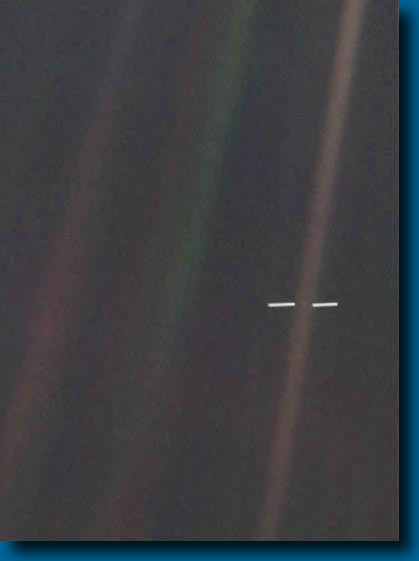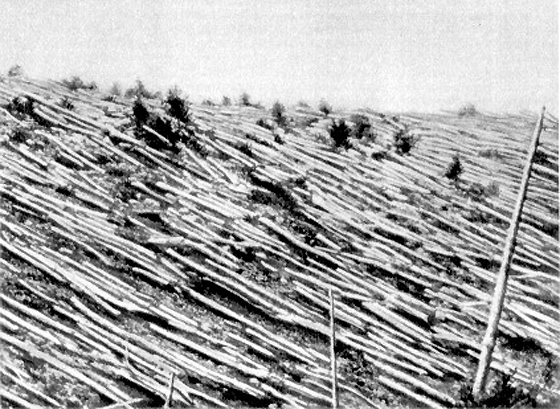A Pale Blue Dot
The photo above was taken by Voyager 1 in 1990 as it sailed away from Earth, more than 4 billion miles in the distance. Having completed it primary mission, Voyager at that time was on its way out of the Solar System, on a trajectory of approximately 32 degrees above the plane of the Solar System. Ground Control issued a command for the distant space craft to turn around and, looking back, take photos of each of the planets it had visited. From Voyager's vast distance, the Earth was captured as a infinitesimal point of light (between the two white tick marks), actually smaller than a single pixel of the photo. The image was taken with a narrow angle camera lens, with the Sun quite close to the field of view. Quite by accident, the Earth was captured in one of the scattered light rays caused by taking the image at an angle so close to the Sun. Dr. Sagan was quite moved by this image of our tiny world. Here is an enlargement of the area around our Pale Blue Dot and an excerpt from the late Dr. Sagan's talk:
.....you can click here to read the rest, but this is the key line from Sagans speech that my Mom and I talked about-
Our planet is a lonely speck in the great enveloping cosmic dark. In our obscurity -- in all this vastness -- there is no hint that help will come from elsewhere to save us from ourselves. It is up to us. .
Which it is of course. I believe that we are in far greater danger of some rogue terrorist group igniting some horrible munition on an unsuspecting populace than we are of a ten thousand meter wide asteroid crashing in to Lake Michigan and drowning a few million people. But I don't think we can really prevent humans from being human. We could potentially avoid the ten thousand meter wide asteroid crashing in to Lake Michigan.
Shouldn't we be at least spending a little more effort thinking about this? I'm all for the Mars and Saturn projects, but won't they pretty much be irrelevant if we get whacked by some big rock?
As always, a little plug for Rusty Schweickart and the folks at the B612 Foundation. There is also the following article from The Lifeboat Foundation that details this undisputed fact-
If we don't do something, sooner or later Earth will be hit by an asteroid large enough to kill all or most of us.
We should be spending more resources working on this problem than we currently are. NASA has a yearly budget ranging in the $15-$20 billion dollar range, and not even 10% of that is used for asteroid mitigation purposes. It is a pale blue dot. And we can't control humans from being human, but this is something we really have a chance to prevent, and we still aren't taking it seriously.
From the Lifeboat Foundation Page-
2.2 HYDROGEN BOMB LEVEL IMPACT

| The energy of the Tunguska asteroid impact would have been equivalent to 10 to 40 Megatons of TNT. Had this happened over a populated area it would constitute one of the greatest natural disasters of all time. |
In 1908 a small asteroid (perhaps 50 meters across) hit Tunguska, Siberia and flattened 60 million trees. That asteroid was so small it never even hit the ground, just exploded in mid-air. If it had arrived four hours and fifty-two minutes later it could have hit St. Petersburg [3]. At the time St. Petersburg was the capital of Russia with a population of a few hundred thousand. The city would have ceased to exist. As it was, dust from the blast lit up the skies of Europe for days. Asteroid strikes this size probably happen about once every hundred years. However, this is just an average. Just because we got hit once doesn't mean we're safe for another hundred years. Indeed, there was another Tunguska-class strike in the Brazilian rain forest on 13 August 1930 [3]. But don't worry, it gets worse.
There are about 1,000 asteroids a kilometer or more in size that cross Earth's orbit (the path Earth takes around the Sun). About a third of these will eventually hit Earth [2] if we don't do something about it. An asteroid strike this large can be reasonably expected to kill a billion people or so, depending on where it hits. A strike in China or India will kill more, in Antarctica less. Even a strike in the ocean would create a tsunami so enormous most people living near the coast would be drowned. A strike of this size is expected about once every 300,000 years or so. We might as well be playing Russian roulette. Admittedly, the revolver has 300,000 cylinders, but if we keep pulling the trigger long enough we'll blow our head off, and there's no guarantee it won't be the next pull.
Happy New Year Everybody!


No comments:
Post a Comment